A mature climbing rose can transform the appearance of your entire landscape and is more than simply another flowering vine. Many cottage gardens are characterized by the sight of an arbor or trellis covered in fragrant rose blooms. These delightful roses can be used to transform an outdoor space and turn it into a meeting place for garden parties and other special occasions.
Do you want to grow your own climbing roses? In this article, we’ll take a look at what climbing roses are and a few varieties for you to choose from.
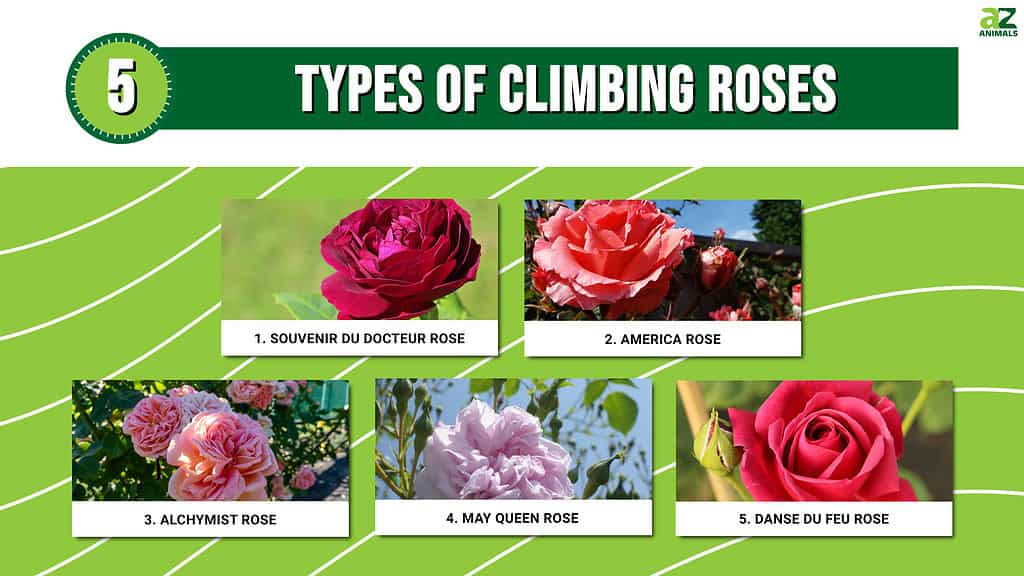
What are Climbing Roses?
You may have lovely blooms not just in your garden beds and pots but also climbing up your walls and over your trellises if you decide to plant climbing roses. Climbing roses are pretty self-explanatory: they are simply varieties of roses that can climb, similar to vines.
It is a bit deceptive to refer to a rose as a “climber” because these plants lack tendrils or suckers that naturally try to cling to a trellis or wall. They are best characterized as extremely tall roses with extraordinarily long canes that can easily fasten to a trellis or other structure. The thorny canes can self-hook into vertical supports, but you usually have to tie the canes up as you grow them.
Climbing roses have comparable growth requirements to other hybrid rose varieties. They need rich soil that drains extremely well, ideally with a pH that is neutral to slightly acidic. They need frequent feeding, like the majority of plants that produce plenty of flowers. During the spring and summer, a fertilizer designed for roses should be administered around every four weeks.
Roses that grow in bushes can be contrasted with climbing roses. The majority of climbing rose varieties produce their most numerous blooms in the spring. However, if your plant is a repeat bloomer, you may anticipate additional blooms as the season progresses.
Why Should I Plant Climbing Roses?
Climbing roses are planted for many different purposes. To start, they are great for vertically filling up your garden. Near the earth is where most flowers grow, so having a vertical flowering plant can give your garden some depth. While you may plant certain kinds that grow to greater heights, climbing roses enable you to expand the height of your plants and add more visual interest.
Climbing roses are naturally simple to cultivate. There are no roses that require zero care, but many people find climbing roses to be easier to handle and less picky than those that grow on bushes. They can thus be an excellent place for a beginner rose grower to start.
Climbing roses come in a huge variety of beautiful types as well. You may discover the ideal climbing rose varieties to adorn your outdoor area with any hues and fragrances you like. Recurring blooms are possible depending on the cultivar. While some kinds of climbing roses only bloom once a season, others flower regularly, giving you a lengthy bloom period to enjoy.
Using climbing roses, you may also fill the top level of your house with a wonderful smell. You can have blooms close to your upper-story windows if you plant a rose that will grow up the wall of your home. That implies that the smell may float inside when you open your windows. You could even be able to see some of them from upstairs, depending on how numerous they are and how near to the window they are.
Adding climbing roses will also help your yard seem more cottage-like. Cottage gardens are becoming popular nowadays. Climbing roses are excellent in assisting you in achieving that homey cottage garden look.
Climbing roses also have a purpose other than merely being pretty. By producing climbing roses, you could do more than just enhance the appearance of your yard. For instance, they can assist you in building a privacy screen that adds to the value of your home.

Climbing roses (pictured) are easy to care for but do require a bit of ongoing maintenance in order to climb.
©ToriNim/Shutterstock.com
How to Care for Your Climbing Rose
Despite their intimidating appearance, climbing roses are simple to grow and provide a dreamy cottage-like appearance. If you have just a little bit of extra time to spare, maintaining these plants can be quite fun.
Typically, climbing roses are mutations or variants of bush or hybrid tea roses. These types generate extraordinarily long canes that keep getting longer, enabling easy manipulation of them to grow up or around a surface. These roses require a little encouragement to begin the process because they lack tendrils or any other means of attaching to a surface. Luckily, it’s easy to train your climbing roses. Begin the training procedure as soon as the roses start to develop. The stems may grow woody and more difficult to handle if you wait too long to give them a decent head start.
Keeping up with the plants from the start might ultimately make a huge impact. It is advisable to have a trellis or other support system a few inches away from the wall if you want to train your roses up a wall or other solid surface. This will make room behind the plants for better ventilation.
Another crucial component of caring for climbing roses is pruning. You may start routinely pruning plants once your climbing rose has established itself. Usually, following the first major flush of flowers, you only need to trim your climbing rose once a year. It’s a good idea to deal with any sick or damaged canes at this time. You should also prune the plant to increase ventilation or guide future development.
As with any rose, disease avoidance is essential for strong, healthy plants. In the spring, be sure to remove any leftover leaf litter from past years’ development. Fungi may be avoided with adequate airflow and sunlight. Numerous fungal infections are the primary problems with roses.
One should also be mindful of pests. Aphids and Japanese beetles are two of the many pests that roses are vulnerable to. Fortunately, with insecticidal soap, these plant pests are simple to eradicate. You can also pick them off for smaller gardens and throw them in a bucket of soapy water. To remove these pests from your plants, you may also give them a powerful water blast from a hose.
5 Climbing Rose Varieties
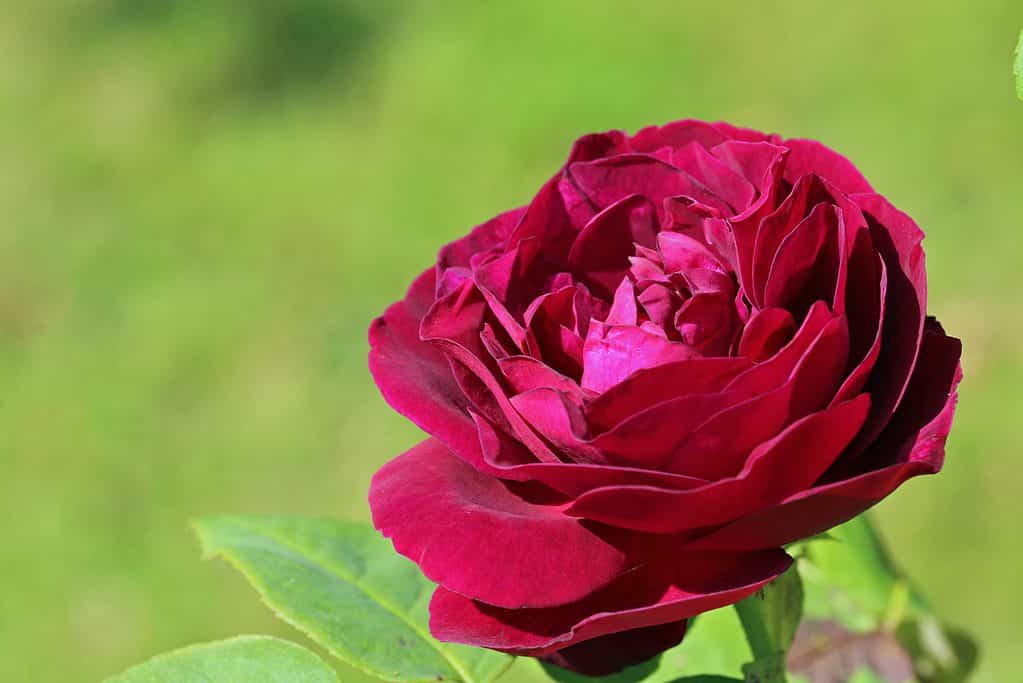
The Souvenir Du Docteur rose (pictured) is prized for its rich color.
©JohnatAPW/Shutterstock.com
1. Souvenir Du Docteur Rose
Botanical Name: Rosa ‘Souvenir du Docteur’
The vintage flowers of this rose, which range in hue from deep crimson to plum, are rightfully sought by people who still cherish the beauty of ancient roses. The Souvenir du Docteur rose has the distinctive strong scent of old roses. To prevent the flowers from turning brown in the intense summer heat, the Souvenir du Docteur rose tolerates some shade and likes it in the afternoon.
This hybrid perennial will bloom throughout the season, but you may get the greatest results by giving it frequent fungicidal treatments to prevent mildew and black spots. They are perfect for a small trellis and are simple to control, but you can even trim them to become shrubs if you choose. This nursery hybrid rose thrives in a little bit of sun. USDA hardiness zones four through nine are suitable for growing it. This magnificent climbing rose should grow to a height of around eight feet.
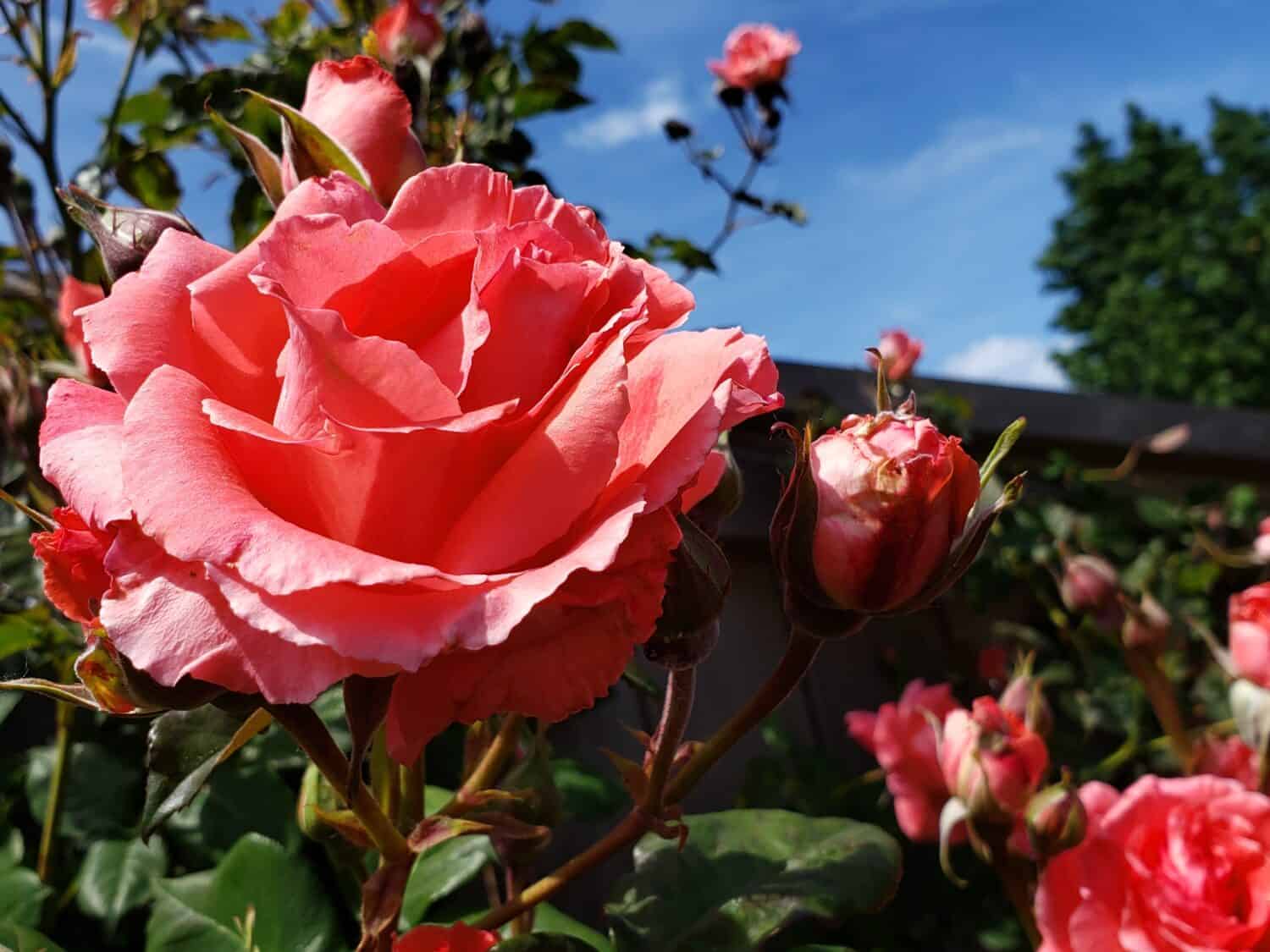
America Rose has a spicy scent and is disease resistant.
Image: Warren Payne, Shutterstock
©Warren Payne/Shutterstock.com
2. America Rose
Botanical Name: Rosa ‘America’
An All-American Rose Selections winner, America Rose was inaugurated as the current climber class. Their coral-pink flowers, which have numerous petals and display the Fragrant Cloud variety’s ancestry, open from large, pointed buds. The blooms of this rose have a spicy scent and are produced in sprays. These disease-resistant, upright plants might take some time to begin climbing. They are hardy in USDA hardiness zones six through nine. They can grow to around eight to 16 feet tall.

The Alchymist rose (pictured) is well-known for its showy and large pink flowers that are perfect for trellises.
©Kristine Rad/Shutterstock.com
3. Alchymist Rose
Botanical Name: Rosa ‘Alchymist’
The Alchymist is a flower worth looking for in bigger gardens due to its extremely high petal count and various dawn colors. This variety will usually only blossom in your garden once each summer, but its potent scent will stay on your mind for the rest of the year. This cultivar, which is more resilient than many climbing roses, can endure winter temperatures as low as negative 30 degrees F. It may be cultivated both as a climber and as a shrub.
For this variety, we recommend planting your Alchymist rose in USDA hardiness zones four through nine. It can reach up to 11 feet high if properly cared for and kept in full sun.
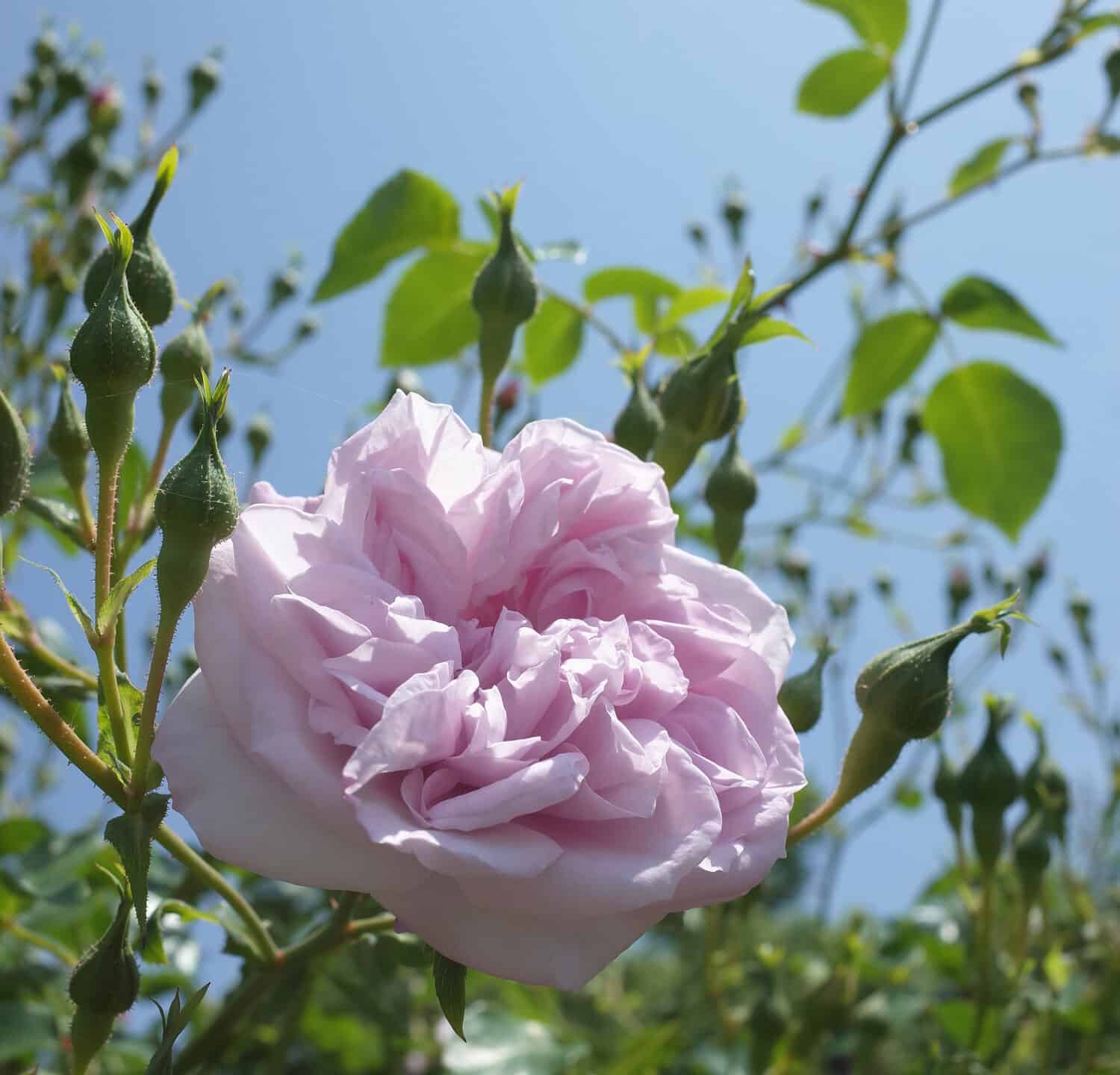
The fluffy pink blossoms of the May Queen Rose bloom once a year in April.
Image: MasterChefNobu, Shutterstock
©MasterChefNobu/Shutterstock.com
4. May Queen Rose
Botanical Name: Rosa ‘May Queen’
The pink blossoms of the May Queen, as fluffy as the beloved peony, bloom only once a year in late April. This climber grows strong enough to outcompete tree roots, so you may grow it into the branches of your favorite tree, where it will disappear into the undergrowth once blooming is over. This exceptionally long rambler will look best when shown against a high trellis or fence.
The May Queen rose is a nursery hybrid that thrives in USDA hardiness zones five through nine. It has a whopping maximum height of 25 feet and does best in full sun exposure, but it can handle the shade of the trees it often climbs on.
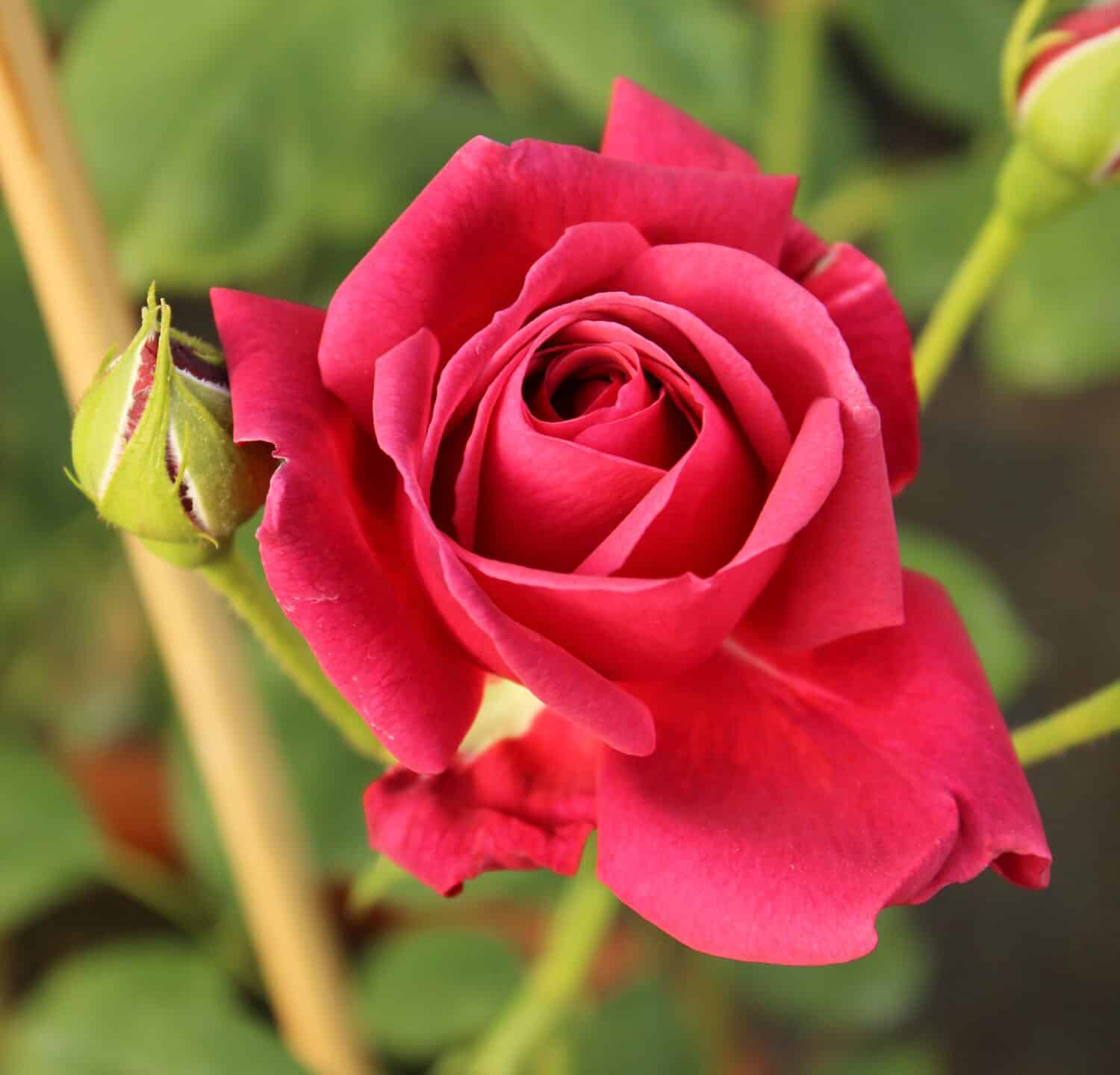
The Danse Du Few Rose has double flowers and a delicate aroma.
Image: N.Stertz, Shutterstock
©N.Stertz/Shutterstock.com
5. Danse Du Feu Rose
Botanical Name: Rosa ‘Danse Du Feu’
The Danse du Feu rose is a climbing floribunda that combines the hardiness of polyantha roses with the free-flowering characteristics of hybrid tea roses. This medium-sized climbing rose has crimson, semi-double flowers that have a delicate aroma. The Danse du Feu rose is a modest grower and will reach its maximum height in approximately four to five years. This type will intermittently bloom throughout the summer and into fall with frequent fertilization.
This rose thrives in USDA hardiness zones six through nine and needs full or partial sun exposure. This rose type is a nursery hybrid with a height range of nine to 13 feet.
All of the climbing roses we’ve discussed in this guide are beautiful in their own right. And growing climbing roses doesn’t require a significant amount of maintenance. With the right variety for your climate and use case, you’ll be able to grow climbing roses that will quickly take over your garden in delightful blooms for years to come.
Summary of 5 Climbing Roses and Their Care Needs
| # | Climbing Rose | Appearance |
|---|---|---|
| 1 | Souvenir Du Docteur Rose | Rich deep crimson to plum-colored velvety blossoms |
| 2 | America Rose | Deep pink-coral blossoms with a spicy aroma |
| 3 | Alchymist Rose | Large, showy pink blossoms with a potent scent |
| 4 | May Queen Rose | Fluffy pink blossoms resemble peonies |
| 5 | Danse Du Feu Rose | Crimson, double-flowered blossoms with delicate scent |
The photo featured at the top of this post is © iStock.com/Vivian Song
Sources
- NCSU Staff, Available here: https://plants.ces.ncsu.edu/plants/rosa/
- Sheryl Geerts, Available here: https://www.bhg.com/gardening/flowers/roses/ultimate-rose-care-guide/
- Jamie McIntosh, Available here: https://www.thespruce.com/climbing-rose-gallery-4050807
FAQs (Frequently Asked Questions)
When should climbing roses be planted?
Climbing roses can be planted around early autumn through early spring, depending on your hardiness zone.
How long do climbing roses take to grow?
Climbing roses take anywhere from three to five years to fully mature.
Do I need a trellis for my climbing roses?
In most cases, trellises or similar structures that are easy to grasp onto are necessary for climbing roses to actually climb.
Thank you for reading! Have some feedback for us? Contact the AZ Animals editorial team.






